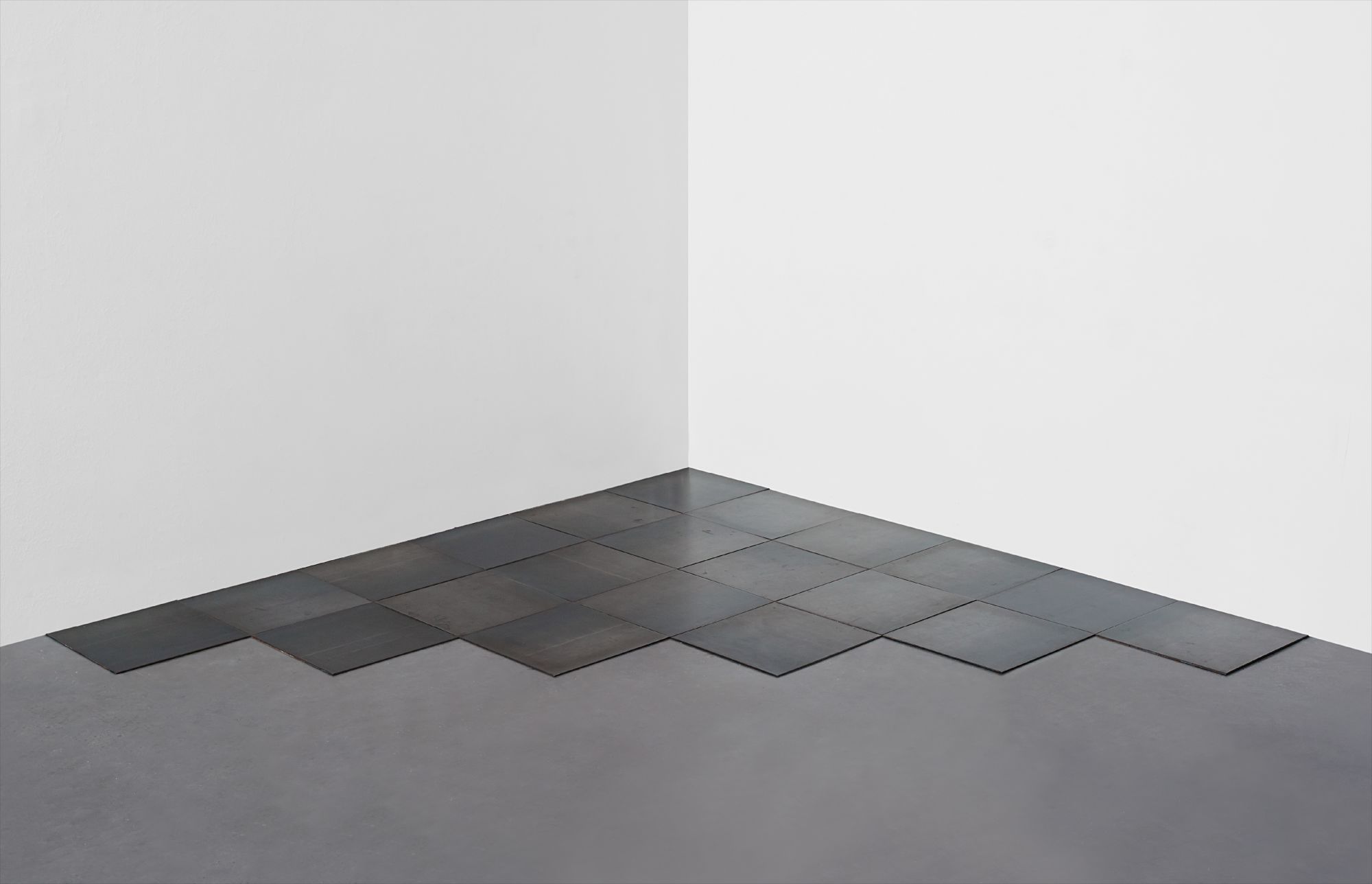

36
Carl Andre
Sixth Steel Corner
steel plates, in 21 parts
each 1/4 x 19 5/8 x 19 5/8 in. (.5 x 50 x 50 cm)
overall 1/4 x 118 1/8 x 118 1/8 in. (.5 x 300 x 300 cm)
overall 1/4 x 118 1/8 x 118 1/8 in. (.5 x 300 x 300 cm)
This work is accompanied by a certificate of authenticity signed by the artist.
Full-Cataloguing
"What the idea of 'minimal art' means to me is that the person has drained and rid himself of the burden, the cultural over-burden that stands shadowing and eclipsing art. I think art is quite apart from that and you have to really rid yourself of those securities and certainties and assumptions and get down to something, which is closer and resembles some kind of blankness. Then one must construct again out of this reduced circumstance." Carl Andre
Carl Andre’s Sixth Steel Corner, 1978 is comprised of 21 steel plates which hug the corner of the room. The tiles, like fingers extending their grip, reach out into the center of the room, slowly creeping into our space. The 21 identical steel squares are equal in weight, size and surface quality; no one piece takes precedence over the other. As a prime example of Minimalist sculpture, this triangular composition powerfully changes the space it inhibits, captivating the room and commanding viewers to approach and interact with it in a newly defined spatial environment. The materials inspire the work, in terms of size and final configuration they underscore the core principles of Minimalism. As Andre commented, “what the idea of 'minimal art' means to me is that the person has drained and rid himself of the burden, the cultural over-burden that stands shadowing and eclipsing art. I think art is quite apart from that and you have to really rid yourself of those securities and certainties and assumptions and get down to something, which is closer and resembles some kind of blankness. Then one must construct again out of this reduced circumstance.” (Carl Andre in A. Rider, Carl Andre: Things in Their Elements, London 2011, p. 249)
The corner location allows the present lot to link the two walls which form the corner while the darkened steel plates act as a negative, cutting into the white walls, highlighting their spatial boundary. The stepped, outward lines of the 6 exterior tiles create a zigzag diagonal across the room, while the corners jut into room, mirroring the larger corner inhabited. Sixth Steel Corner, 1978 represents Andre’s mastery of his sculptural craft. The present lot has not only adapted to its environment, melting subtly into the floor, but also acts as a reflection of its shifting geographical surroundings. This subtle transformation of space is Andre’s desired effect: “My works are in [a] constant state of change. I'm not interested in reaching an ideal state with my works. As people walk on them, as the steel rusts, as the brick crumbles, as the materials weather, the work becomes its own record of everything that's happened to it." (C Andre in D. Bourdon, “A Redefinition of Sculpture,” Carl Andre: Sculpture 1959-1977, New York, 1978, p. 32)
Carl Andre’s Sixth Steel Corner, 1978 is comprised of 21 steel plates which hug the corner of the room. The tiles, like fingers extending their grip, reach out into the center of the room, slowly creeping into our space. The 21 identical steel squares are equal in weight, size and surface quality; no one piece takes precedence over the other. As a prime example of Minimalist sculpture, this triangular composition powerfully changes the space it inhibits, captivating the room and commanding viewers to approach and interact with it in a newly defined spatial environment. The materials inspire the work, in terms of size and final configuration they underscore the core principles of Minimalism. As Andre commented, “what the idea of 'minimal art' means to me is that the person has drained and rid himself of the burden, the cultural over-burden that stands shadowing and eclipsing art. I think art is quite apart from that and you have to really rid yourself of those securities and certainties and assumptions and get down to something, which is closer and resembles some kind of blankness. Then one must construct again out of this reduced circumstance.” (Carl Andre in A. Rider, Carl Andre: Things in Their Elements, London 2011, p. 249)
The corner location allows the present lot to link the two walls which form the corner while the darkened steel plates act as a negative, cutting into the white walls, highlighting their spatial boundary. The stepped, outward lines of the 6 exterior tiles create a zigzag diagonal across the room, while the corners jut into room, mirroring the larger corner inhabited. Sixth Steel Corner, 1978 represents Andre’s mastery of his sculptural craft. The present lot has not only adapted to its environment, melting subtly into the floor, but also acts as a reflection of its shifting geographical surroundings. This subtle transformation of space is Andre’s desired effect: “My works are in [a] constant state of change. I'm not interested in reaching an ideal state with my works. As people walk on them, as the steel rusts, as the brick crumbles, as the materials weather, the work becomes its own record of everything that's happened to it." (C Andre in D. Bourdon, “A Redefinition of Sculpture,” Carl Andre: Sculpture 1959-1977, New York, 1978, p. 32)